Notes For All Chapters Science Class 10 CBSE
Heredity and Inherited Traits: Mendel’s Experiment; Sex determination.
Heredity refers to the transmission of characters from parents to offsprings. An inherited trait is a particular genetically determined feature that distinguishes a person from the others for example; attached or free ear lobes in human beings.
Rules for the inheritance of traits:
Mendel’s contribution: The rules for inheritance of traits in human beings are related to the fact that both mother and father contribute an equal amount of genetic material i.e. DNA to their offspring. So an offspring will get two versions of that trait from the two parents. Mendel worked out rules for inheritance of these traits. Gregor Johann Mendel regarded as the ‘Father of Genetics’ performed his experiments with garden peas (Pisum sativum) in the garden behind his monastery. He observed a number of contrasting characters in garden peas and observed their inheritance.
Some important terms
1. Chromosomes are long thread-like structures present in the nucleus of a cell which contain hereditary information of the cell in the form of genes.
2. DNA is a chemical in the chromosome which carries the traits in a coded form.
3. Gene is the part of a chromosome which controls a specific biological function.
4. Contrasting characters: A pair of visible charactes such as tall and dwarf, white and violet flowers, round and wrinkled seeds, green and yellow seeds etc.
5. Dominant trait: The character which expresses itself in a (Ft) generation is dominant trait. Example : Tallness is a dominant character in pea plant.
6. Recessive trait: The character which does not express itself but is present in a generation is recessive trait. Ex. dwarfism in the pea plant.
7. Homozygous: A condition in which both the genes of same type are present for example; an organism has both the genes for tallness it is expressed as TT and genes for dwarfness are written as tt.
8. Heterozygous: A condition in which both the genes are of different types for example; an organism has genes Tt it means it has a gene for tallness and the other for dwarfness only tall character is expressed.
9. Genotype: It is genetic make up of an individual for example; A pure tall plant is expressed as TT and hybrid tall as Tt.
10. Phenotype: It is external appearance of the organism for example; a plant having Tt composition will appear tall although it has gene for dwarfness.
11. Homologous pair of characters are those in which one member is contributed by the father and the other member by the mother and both have genes for the same character at the same position.
Mendel’s Experiment: Mendel started his experiment on the pea plants. He conducted first monohybrid and then dihybrid crosses.
Monohybrid Cross: The cross in which Mendel showed inheritance of dominant and recessive characters is monohybrid cross. To observe inheritance of single pair of contrasting characters
he took pure tall (genotype TT) and pure dwarf (genotype tt) pea plants and cross pollinated them to obtain first generation or first filial generation. In this figuration (F1 generation) he obtained only tall plants. This meant that only one of the parental traits was seen, not the mixture of the two. The plants of F generation or progeny are then self pollinated to obtain F2 generation or progeny. Now all plants were not tall. He obtained 75% tall plants and 25% dwarf plants i.e. the phenotypic ratio was 3:1. This indicates that in the F, generation both tall and dwarf traits were inherited but tallness expressed it self. Tallness is a dominant trait and dwarfness is a recessive trait. F2 generation has a genotypic ratio of 1 : 2 : 1 of three types of plants represented by TT, Tt and tt as shown in the cross.
Conclusion: Phenotypic ratio—Tall : Dwarf 3 : 1
Genotype ratio—Pure Tall : Hybrid Tall : Pure Dwarf 1 : 2 : 1
Law of Dominance: When parents having pure contrasting characters are crossed then only one character expresses itself in the Ft generation. This character is the dominant character and the character/factor which cannot express itself is called the recessive character.
Dihybrid Cross: Mendel also carried out experiments to observe inheritance of two pairs of contrasting characters, which is called dihybrid cross. He cross breed pea plants bearing round green seed with plants bearing wrinkled and yellow seeds. In the Fx generation he obtained all round and yellow seeds it means round and yellow traits of seeds are dominant features while wrinkled and green are recessive. He self-pollinated the plants of F: generation to obtain F2 generation, he obtained four different types of seeds round yellow, round green, wrinkled yellow and wrinkled green in the ratio of 9 : 3 : 3 : 1. He concluded that traits are independently inherited
Conclusion
- Round and yellow seeds-9.
- Round and green seeds-3.
- Wrinkled and yellow seeds-3.
- Wrinkled and green seeds-1.
How do traits get expressed?
Cellular DNA is the information source for making proteins in the cell.
A part of DNA that provides information for one particular protein is called a gene for that protein for example; the height of a plant depends upon the growth hormone which is in turn controlled by the gene. If the gene is efficient and more growth hormone is secreted the plant will grow tall. If the gene for that particular protein gets altered and less of it is secreted when the plant will remain short. Both the parents contribute equally to the DNA of next generation during sexual reproduction. They actually contribute a copy of the same gene for example; when tall plant is crossed with short plant the gametes will have single gene either for tallness or for shortness. F1 generation will get one gene for tallness and other for shortness also.
How do germ cells i.e. gametes get single set of genes from parents who have two copies in them ?
Each gene set is present, not as a single long thread of DNA, but as separate independent pieces each called a chromosome. Each cell gets two copies of the chromosome, one from each parent. Each germ cell or gamete has one copy of it because there is reductional division in the sex organs at the time of formation of gametes. When fertilization takes place normal number of chromosomes is restored in the progeny ensuring the stability of DNA of the species.
How is the sex of a newborn individual determined?
It is the process by which sex of a newborn can be determined.
Different species use different strategies for this :
- In some animals the temperature at which fertilized eggs are kept determines whether the developing animals will be males or females.
- Some animals like snails can change sex indicating that sex is not genetically determined.
- In human beings sex of the individual is determined genetically; means genes inherited from the parents decide the sex of the offspring.
Sex determination in human beings: In human beings, all chromosomes are not paired. 22 chromosomes are paired but one pair called sex chromosome is odd in not having a perfect pair in males. Females have a perfect pair both represented by XX. On the other hand males have a normal sized X but the other is short called Y so it is shown as XY. All gametes or ova formed by the homogenetic female are similar i.e. have X chromosome. Males heterogenetic form two types of sperms i.e. half with X chromosome and the other half with Y chromosome. Sex of the baby will depend on fertilization. There are two possibilities :
Autosomes: Those chromosomes which do not play any role in sex determination.
Sex chromosomes: Those chromosomes which play a role in determining sex of the newborn.
- If the sperm having X chromosome fertilizes with ovum with X chromosome then the baby will have XX chromosome and it will be female.
- If the sperm having Y chromosome fertilizes with ovum with X chromosome then the baby will have XY chromosomes and it will be male.
Evolution: Acquired and inherited traits, Speciation, Evolution and classification, Evolution by stages, Human evolution.
Evolution: It is the sequence, of gradual, irreversible changes which took place in the primitive organisms over millions of years to form new present-day species. Variations that resulted in formation of new species occurred basically due to errors in DNA copying as well as due to sexual reproduction.
An Illustration to show variations in a population: A group of twelve red beetles live in green bushes and reproduce sexually so are likely to develop variations. There are the following possibilities
First situation: Crows eat these beetles as they can easily pick up red ones in the green bushes There is a colour variation during sexual reproduction and green beetles appears, it reproduces and its population increases. Crows are not able to see green beetles so their population continues to increase but that of red beetles decreases. This type of variation gives a survival advantage.
Second situation: Due to a colour variation few blue beetle appear forming blue population. Crows can see both red and blue and eat them. Initially there are more of red beetles and less of blue. There is sudden calamity, an elephant kills red beetles by stamping on bush, blue beetles survive reproduce and increase in number. In this case there is no survival advantage but provides diversity without any adaptation.
Third situation: As the population of beetles increases, the bushes suffer from a disease and the availability of food for beetles decreases. The size of beetles decrease but after a few years as the plant disease is eliminated and enough food is available for the beetles they come back to their normal size. This type of change is not inherited.
Acquired Traits: Acquired traits are those which are not inherited over generations as they are caused due to change in the non-reproductive tissue and are not passed on the DNA of the germ cells for example; the size of the beetles in the population decreased due to scarcity of food.
Inherited Trait: Inherited traits are caused due to changes in the DNA of germ cells which are inherited from generation to generation, for example; formation of green beetles in the population of red beetles.
Acquired Traits and Inherited Traits
| Acquired Traits | Inherited Traits |
| (i) These are the traits which are developed in an individual due to special conditions. | (i) These are the traits which are passed from one generation to the next. |
| (ii) They cannot be transferred to the progeny. | (ii) They get transferred to the progeny. |
| (iii) They cannot direct evolution, e.g. low weight of starving beetles. | (iii) They cannot direct evolution, e.g. low weight of starving beetles. |
Charles Darwin’s Idea of Evolution: His concept of evolution was based on the idea that new species were formed due to variations that occurred in the organisms Nature played an important role in selecting the organisms having suitable variations.
Speciation: It means the development of one or more species from an existing species The factors that could lead to rise of a new species are :
Gene flow: It means the exchange of genetic material by interbreeding between populations of the same species or between individuals within a population. It increases the variation in the genetic composition of a population.
Genetic drift: It is random change in the frequency of alleles in a populate over successive generation due to errors in the gametes. The process is rapid in smaller population. Genetic drift can lead to accumulation of changes in the generations.
Natural selection: According to Darwin, natural selection also plays an important role in bringing about evolution of new species of plants and animals. According to him variations existed between the individuals of a population and some natural phenomena eliminated those individuals which were less adapted. The surviving population would pass the hereditary advantageous features to their offsprings. With time this process would give rise to organisms different from the original population and new species are formed.
Isolation: When a population of a species splits into two, it cannot reproduce with each other and forms a new species, for example; when a population of beetles feed on bushes on a mountain range, some may start feeding on nearby bushes finding entry into a new subpopulation. They reproduce with them so genes enter in a new population. Ultimately the two groups will be incapable of reproducing with each other and new species will be formed.
Evolution and Classification: The organisms show certain features, like appearance and behaviour which are called characteristics for example; Plants can perform photosynthesis. The basic characteristics are shared by a large number of organisms. More characteristics which two species have in common more closely are related, if they are more closely related then they have common ancestors (explain the example of brother sister and cousins). Evolutionary relationships can be traced with the help of the following :
Homologous organs: Those organs which have the same basic structural design and developmental origin but perform different functions and appearance, for example; Forelimbs of frog, lizard, bird, bat and human beings. They have same design of bones but they perform different functions.
Analogous organs: Those organs which have different basic design and developmental origin but have similar appearance and perform a similar function, for example; wings of bat and bird. Wings of bat are folds of skin attached between fingers. But wing of birds are modified forelimbs.
Study of Fossils: Fossils are preserved remains of living organisms that lived in the past. When living organisms die their bodies decompose but some parts of their body may be in such an environment that they do not decompose for example; if a dead insect gets caught in hot mud it will not decompose quickly but the mud will harden and retain impressions of the body parts of the insects. These impressions are also called fossils: The age of fossil can be estimated in two ways :
The fossils that occur closer to earth surface are more recent to those found in deeper layers.
The second method is isotope dating i.e. detecting the ratio of different isotopes of the same element in the fossil material.
Significance of fossils: Fossils are formed layer by layer in the earths crust. The animals and plants which existed earlier are buried in the deeper layer which ones found in the upper layer. It is found that, deeper fossils have simpler structure than found than upper layer. Complete fossil record of animals like horse, camel, man has helped us to study the stages of evolution.
Evolution by stages: Evolution is a continuous and gradual process, complicated organs did not evolve by a single DNA change but were formed by bit by bit change over generations for example; complex organs like eyes were created by bit by bit changes, in between the rudimentary eye in some insects also provided a fitness advantage. The structure of eye in all organisms is different enough to have evolutionary origins. Some organs even developed for one particular function but later become useful for quite a different function, e.g Feathers developed to provide warmth to the animal but later helped in flight.
Some dinosaurs had feathers although they could not fly, this shows that birds are closely related to reptiles, since dinosaurs were reptiles Some dissimilar looking structures also evolved from common ancestors. The current example of such a process is wild cabbage plant from which different vegetables are generated by artificial selection rather than natural selection
- Selection of short distance between the leaves has led to formation of cabbage that, we eat.
- Selection for arrested flower development had led to broccoli,
- Selection for sterile flowers had made cauliflower,
- Selection for swollen-stem had formed kohlrabi.
- Selection for large leaves had formed leafy vegetable kale,
- Selection for colored leaves formed red cabbage.
To sum up we can say that evolutionary relationships can be established by
- Study of Homologous organs
- Study of Analogous organs
- Study of fossils
- Changes in DNA during reproduction
Evolution versus Progress: Evolution can not be called progress from lower forms to higher forms. It is basically forming more complex designs while the simpler once also keep growing. Evolution is generation of diversity with the help of environmental selection. Bacteria which were formed first have the capacity to live in diverse conditions and are still flourishing; on the other hand human beings which are highly evolved species can not be called the pinnacle of evolution but yet another species in the evolving life forms.
Human Evolution: Human evolution has been studied with the help of excavation; time dating and fossil study All human beings belong to single species i.e. Homo sapiens. Human species have come from Africa. Some of our ancestors left Africa while others stayed on. These migrants slowly spread across the planet i.e. West Asia, Central Asia, Eurasia, South Asia and East Asia They traveled to Indonesia, the Philippines, Australia and America They traveled forward and backward sometimes separating and sometimes coming back to mix with each other. They had come into being as an accident of evolution.
Although there is a great diversity of human forms all over the world get all humans are single species.
- They didn’t go in a single line.
- They went forward and backward.
- Moved in and out of Africa.
- Sometimes come back to mix with each other.
Genetics: Branch of science that deals with heredity and variation.
Heredity: It means the transmission of features/characters/traits from one generation to the next generation.
Variation: The differences among the individuals of a species/population are called variations.
Mendel and his work on Inheritance.
Gregor Johann Mendel started his experiments on plant breeding and hybridisation. Mendel was known as Father of Genetics.
The plant selected by Mendel was Pisutn sativum (garden pea). Mendel used a number of contrasting characters for garden pea.
Sex Determination: Phenomenon of decision or determination of sex of an offspring.
Factors Responsible for Sex Determination:
- Environmental: In some animals, the temperature at which the fertilised eggs are kept decides the gender. Example, in turtle.
- Genetic: In some animals like humans gender or individual is determined by a pair of chromosomes called sex chromosomes (XX – female; XY – male).
Sex Chromosomes: In human beings, there are 23 pairs of chromosomes. Out of these 22 chromosome pairs are called autosomes and the last pair of chromosomes that help in deciding the gender of that individual are called sex chromosome.
XX – female; XY – male
The cross done shows that half the children will be boys and half will be girls. All children will inherit an X chromosome from their mother regardless of whether they are boys or girls. Thus sex of children will be determined by what they inherit from their father, and not from their mother.
Acquired Traits:
- These are the traits which are developed in an individual due to special conditions.
- They cannot be transferred to the progeny.
- They cannot direct evolution, for example, the low weight of starving beetles.
Inherited Traits:
- These are the traits which are passed from one generation to the next.
- They get transferred to the progeny.
- They are helpful in evolution, for example, the colour of eyes and hair.
Microevolution: It is the evolution which takes place on a small scale. Example, change in body colour of beetles.
Speciation: It is the process of formation of new species. A species is a group of similar individuals that belong to a population that can interbreed and produce fertile offspring. Speciation takes place when the variation is combined with geographical isolation.
Gene flow: It is the exchange of genetic material by interbreeding between populations of the same species or individuals. Gene flow occurs between populations that are partly but not completely separated.
Genetic Drift: It is the random change in the frequency of alleles (gene pair) in a population over successive generations.
Genetic drift takes place due to:
- severe changes in the DNA.
- change in the number of chromosomes.
Natural Selection: The process by which nature selects and consolidates those organisms which are more suitably adapted and possesses favourable variations.
Evolution and classification. Both evolution and classification are interlinked.
- Classification of species is a reflection of their evolutionary relationship.
- The more characteristics two species have in common the more closely they are related.
- The more closely they are related, the more recently they have a common ancestor.
- Similarities among organisms allow us to group them together and to study their characteristics.
Tracing Evolutionary Relationships:
- Homologous Organs: Morphological and anatomical evidences. These are the organs that have same basic structural plan and origin but different functions.
Example, forelimb of a horse (running), wings of bat (flying), paw of a cat (walk/ scratch/ attack) — same basic structure but different functions. - Analogous Organs: These are the organs that have different origin and structural plan but same functions.
Example, wings of a bat (elongated fingers with skin folds), wings of bird (feathery covering along the arm) — different structures but same functions. - Fossils: The remains and relics of dead organisms that lived in the remote past. Fossils provide evidence of evolution. Example, a fossil called Archaeopteryx has feathered wings like birds but teeth and tail like reptiles hence suggesting that birds and reptiles had a common ancestor.
Artificial Selection: Humans have been a powerful agent in modifying wild species to suit their own requirement throughout ages by using artificial selection. Example, wheat (many varieties obtained due to artificial selection).
1. Heredity : It refers to the transmission of characters or traits from the parents to their offspring. Heredity is the continuity of features from one generation to another which are present in fertilised egg or zygote. The zygote develops into an organism of a particular type only.
2. Genetics : It is the branch of biology which deals with heredity and variation. Genetics is to help our understanding of heredity by knowing how offspring inherit characteristics from their parents.
3. Variation : It means the differences in the characters or traits among the individuals of a species. Variations occur during reproduction both because of error in DNA copying and as a result of sexual reproduction. Variations contribute to evolution.
Causes of variations:
- Different combinations of genetic material.
- Some positive gene mutations.
- Interaction of genes with environmental changes (adaptations).
Importance of variations:
- It forms, the. basis of heredity.
- It causes adaptations due to which organism can easily adjust to its changing environment.
- Accumulation of variations forms the basis of evolution.
Remember!
Variations are produced both in sexual and asexual reproduction but amount of variations produced in asexual reproduction are subtle (so little) that they are hardly noticeable as compared to variations caused due to sexual reproduction.
4. Genotype : The genetic constitution of an organism e.g., Genotype of human male is 44 + XY and
genotype of human female is 44 + XX
5. Phenotype : The appearance of the organism, i.e., the way in which genotype is expressed. Phenotype is the result of interaction of genes with the environment.
e.g., Red colour may be controlled by a pair of genes RR. Now if genotype is RR phenotype will be red only but if genotype is Rr then also phenotype will be red since R is a dominant gene.
6. Gene : It is the basic unit of inheritance by which characters are transferred from parents to their offspring. Gene consists of a specific length of DNA on a chromosome. A specific Segment of DNA that provides the information for one protein is called gene for that protein.
According to Mendel, both parents must contribute equally to the DNA of the progeny during sexual reproduction. As both parents determine the trait in the progeny, so both parents must be contributing a copy of the same gene.
7. Chromosomes : These are the long threads present in the nucleus of every cell. Chromosomes are made- up of DNA and protein. Each chromosome contains very long molecule of DNA.
Remember!
Each gene set is present as separate independent pieces each called a chromosome. Each cell have two copies of each chromosome, one each from male and female parents. Every germ cell will take one chromosome from each pair and these may be of either maternal or paternal origin. When two germ cells combine, they will restore the normal number of chromosomes in the progeny, ensuring the stability of the DNA of the species. Such mechanism of inheritance is used by all sexually and asexually reproducing organisms.
8. Allele: It is an alternative form of a gene occupying the same position on a chromosome and affecting the same characters but in two alternative ways, e.g., the free and attached ear lobe are the alleles of ear lobe character.
Expressing allele of a gene :
- Homozygous dominant in capital letters, e.g., tallness(TT)
- Homozygous recessive in smalMetters, e.g., shortness or dwarfness (tt)
- Heterozygous (Tt)-lt will be called hybrid tall.
9. Dominant allele: An allele that affects the phenotype of an organism both in heterozygous and homozygous condition. It is denoted by a capital letter, e.g., tallness in pea plant is denoted by ‘T.
10. Recessive allele: An allele that affects the phenotype of the organism in absence of a dominant allele, i.e., in homozygous recessive individuals. It is denoted by a small alphabet, e.g., dwarfness in pea plant is denoted by’t’.
11. Homozygous: When both alleles of a particular gene are the same, e.g., TT
12. Heterozygous : When both alleles of a particular gene are different, e.g., Tt
13. Diploid : Cells or organism containing two sets of genes, e.g., human body cells. Diploid cells have genetic constitution of 2n.
14. Haploid : Cells or organism containing one set of genes, e.g., human reproductive cells (sperms and ova). Haploid cells have genetic constitution of n.
15. Monohybrid cross : A cross between two parents taking the alternative traits of one single character, e.g., A cross between tall and dwarf pea plants.
Monohybrid Ratio :
- In F1 generation : 100% hybrid
- In F2 generation : phenotypic ratio is 3 : 1 and genotypic ratio is 1 : 2 : 1
16. Dihybrid cross: A cross between two parents taking into consideration alternative traits of two different characters, e.g., A cross between two pea plants one having round, green seeds and the other having wrinkled, yellow seeds.
Dihybrid Ratio :
- F1 ratio is 100% Hybrid type.
- F2 ratio : Phenotypic is 9 : 3 : 3 : 1 and Genotypic . ratio is very complex.
17. Human Blood Groups: There are four types of blood groups A, B, AB or O. These are controlled by a gene which is denoted by symbols IA, IB and IO (sometimes also denoted as i). The genes IA and IB show no dominance over each other (they are codominant, i.e., both expresses themselves independently). But these both genes are dominant over the gene IO. Therefore, blood group of a person depends on the type of genes present, e.g., (i) Blood group A has the following gene types :
18. Determining sex of a newborn individual genetically:
- In human beings the sex of the individual is ” determined genetically.
- There are 23 pairs of chromosomes of which 22 are similar in male and female and are known as autosomes.
- The remaining one is sex chromosome which is XY in males and XX in females.
- Males produce two types of sperms X and Y, while female produces one type of egg X.
- If a X type of sperm fertilizers the egg then the sex of baby will be female (XX).
- If Y type of sperm fertilizers the egg then the sex of the baby will be male (XY).
19. Mendel’s experiment to show that traits may be dominant or recessive:
- Mendel conducted breeding experiments in garden pea.
- selected pure plant of a tall/short plant.
- produced first generation plants by crossing them.
- found that all plants were tall.
- produced the second generation by self-fertilization of hybrids.
- found that three-quarter of the plants was tall and one quarter was short.
20. Homologous chromosomes: A pair of corresponding chromosomes of the same shape and size, one from each parent.
21. Autosomes and Sex chromosomes : The identical » chromosome pairs are called autosomes. The
chromosome pair which is different are called sex chromosomes. Humans have 23 pairs of chromosomes. 1-22 pairs are autosomes while 23rd pair (XX in females and XY in males) which are designated as X and Y are sex chromosomes.
22. Molecular Phylogeny: It is the study of evolutionary relationships by comparing DNA of different species.
23. Natural selection : Natural selection is one of the basic mechanisms of evolution, along with mutation, migration and genetic drift. Natural selection means the environmental conditions prevailing around an organism against which organism adapts itself, grows – and reproduces further. This leads to a change in the composition of genes within a population further causing evolution. Thus, it can be said that,
Natural selection results in adaptation in population to fit their environment better. Thus, natural selection direct evolution in the population of a particular species.
24. Fossils of the information which they provide regarding evolution: Fossils are the remains of ancient life forms, which got preserved somehow in the layers of earth, snow or oil.
Information given by fossils:
- They reveal that the life forms which existed earlier do not exist today which indicate that the living forms are ever changing (evolving).
- They are used to guess the time when a particular organism existed on earth. It is done through carbon dating.
25. Genetic drift: The change in the frequency of some genes in a population which provides diversity without any survival advantage is called genetic drift.
26. The various ways in which individuals with a particular trait may increase in a population : Differences in population are responsible for the diversity such as, colour of eyes, hair, shape of ear lobes. This occurs due to : (i) Sexual reproduction (ii) Inaccuracies during DNA replication (iii) Due to environmental changes. This diversity will increase with time as these variations can be passed on only through DNA/genes during reproduction through reproductive tissue (germ cells or gametes).
- If these variations give survival advantage, then such traits are selected in nature and such traits increase in a population.
- Due to genetic drift. This occurs due to geographical or reproductive isolation. It results in the change in gene frequency in a particular: population.
- Migration which leads to gene flow in and out of the population.
- The mutation caused due to particular type of environment. ,
- Acquired traits due to particular type of environment.
27. Evidence of evolution: Errors in DNA copying (mutation) and sexual reproduction lead to variations which form the basis of evolution. Characteristics that
are common in different kinds of living organisms provide evidence in favour of evolution.
28.Evolution : Evolution can be defined as a naturally occurring slow, continuous and irreversible process of change. The gradual change of living organisms from pre-existing organisms since the beginning of life is called organic evolution. Whereas, gradual change in elements from one form to another with time is termed as inorganic evolution, i.
29.Inherited traits : are those traits which are passed from one generation to another through specific genes. Any change in DNA of the germ cells will be passed.
30. Acquired traits : are those traits which are acquired by the organism in its lifetime, e.g., removal of tail cannot change the genes of the germ cells of the mice thus cannot be passed to next generation.
31. Speciation : It means the origin of new species from the existing ones. It happens when different populations of the same species evolve along different lines.
How speciation occurs ?
- It occurs when two populations are isolated (both geographically and reproductively) leading to almost no gene flow between the two populations.
- Over generations, genetic drift will accumulate different changes in each sub-population.
- Natural selection may also operate differently in these different locations.
- Together natural selection and genetic drift will cause such changes (severe changes in the DNA) that these two groups will not be able to reproduce with each other even if they happen to meet.
- When DNA changes occur to larger extent, it may lead to change in the number of chromosomes or gene expression, eventually the germ cells of the two groups cannot fuse with each other. This leads to emergence of new species.
32. Estimating Age of Fossil: There are 2 methods :
- Relative method : On digging, the fossils which are closer to the surface are more recent than the fossils found in deeper layers.
- Dating fossils (carbon dating method): It is done by detecting the ratios of different isotopes of the same element (i.e., isotope of C-14 which is radioactive) in the fossil material.
33. Evolution by stages :
Complex organs like eye has evolved from rudimentary organs, (e.g., rudimentary eye in flatworm might be useful enough to give only a fitness advantage and the structure of eye in different organisms is different indicating them to have different evolutionary origins) not by a single DNA change but created bit-by-bit over generations.
A change that is useful for one property to start with can become useful later for quite a different
function (e.g., Feathers might start as providing insulation in cold weather. But later, they might be useful for flight. Some heavy birds and reptiles also have feathers but they do not fly.
Some very dissimilar looking structures evolve from a common ancestral design, e.g., wild cabbage was cultivated as a food plant and many different vegetables were generated by selection over last two thousand years, (a) Selection of very small distances between the leaves gave rise to cabbage we eat. (b) Selection for arrested flower development gave rise to broccoli, (c) Selection for sterile flowers gave rise to cauliflower (d) Selection for swollen parts gave rise to kohlrabi.(e) Selection for larger leaves gave rise to leafy vegetable kale. It suggests that, if these selections were not done then there would have been only wild cabbage.
34. Homologous organs are organs having same origin and basic structure but they appear different and perform different functions in various organisms,
e.g.,
- Forelimbs of horse and arms of man.
- Wings of birds and flippers of whale.
Similarities in basic structure of (homologous) organs in different organisms, indifferent groups indicate common ancestry.
35. Analogous organs are organs, which look similar because they perform same function, but they do not have same origin and basic structure.
e.g.,
- Wings of birds and wings of insects.
- Fins of fish and flippers of the whale.
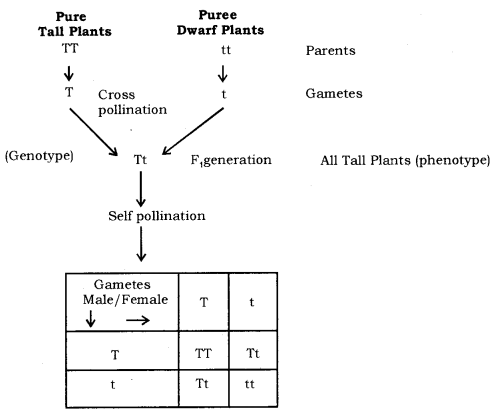
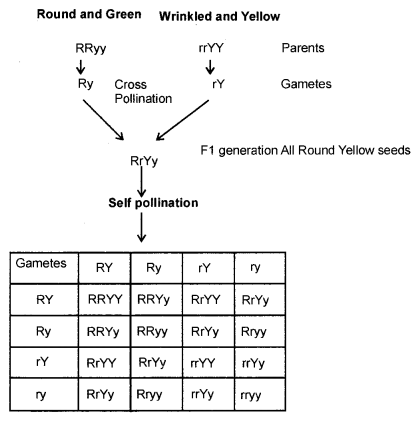
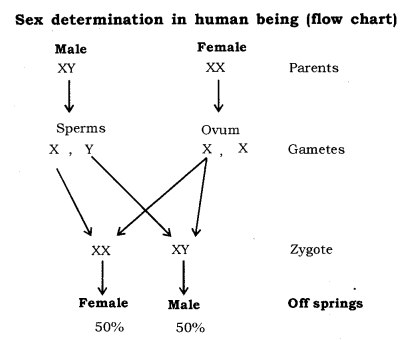
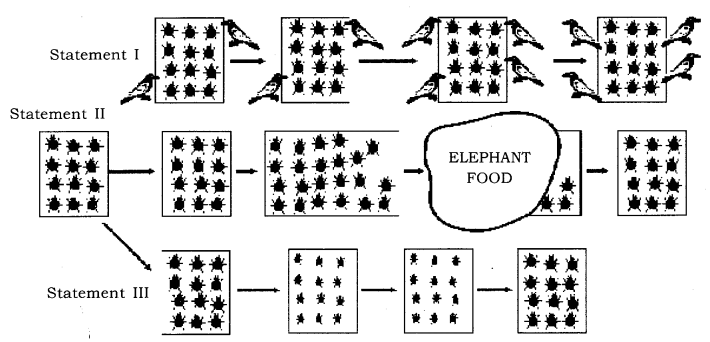
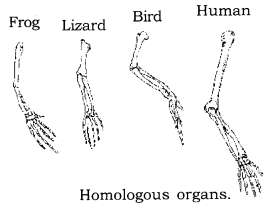

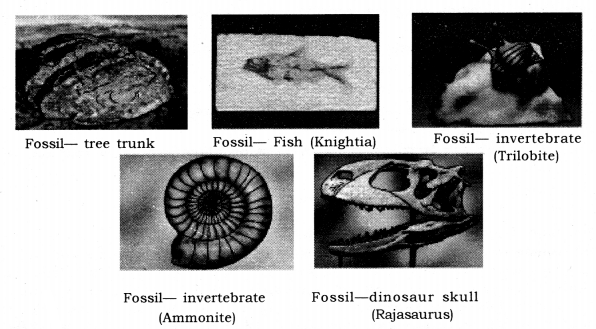
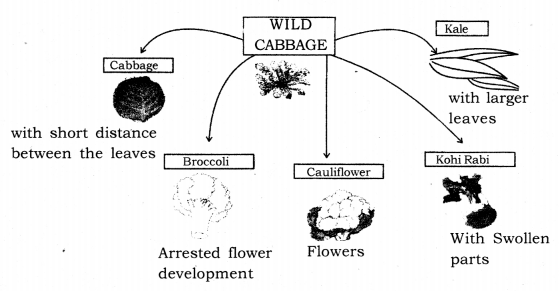
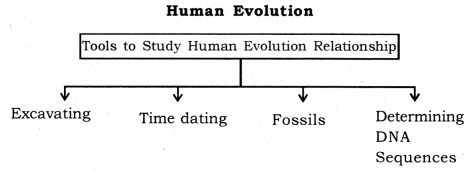
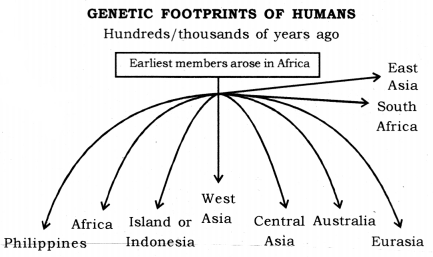

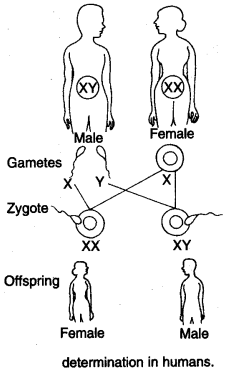

Leave a Reply